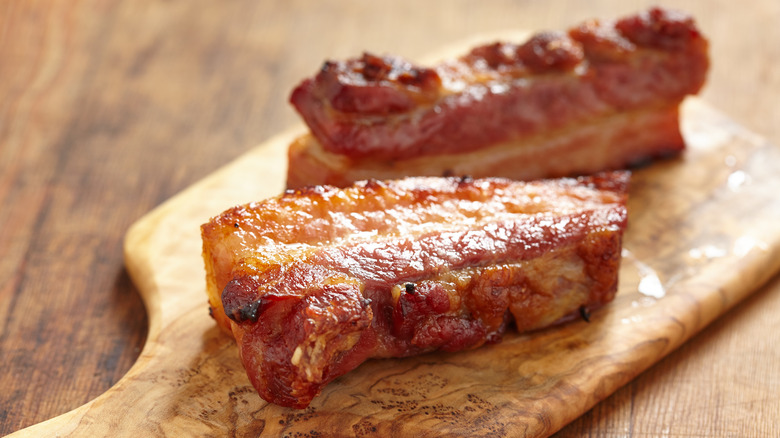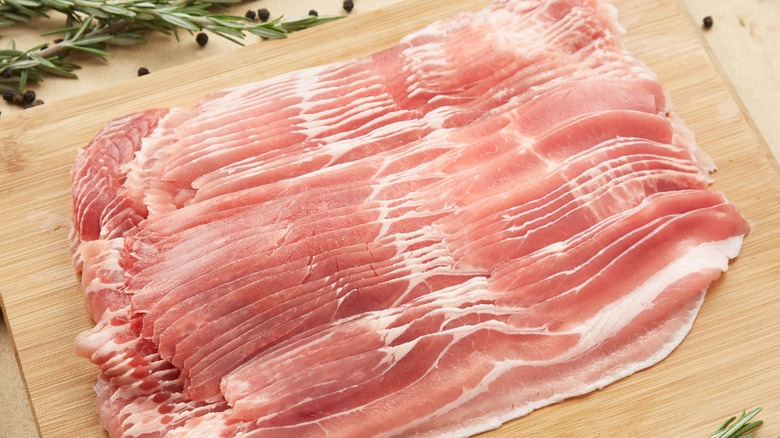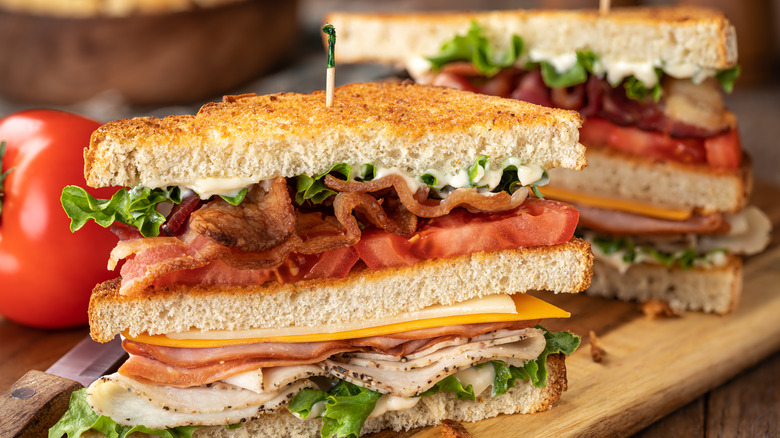What's The Difference Between Pork Belly And Bacon?
Few sensory experiences stir the gastronome's soul like the smell of cooking bacon, and its delicious taste has captured imaginations worldwide. An article by The Meat We Eat explains that bacon's broad appeal catapulted it into favored-ingredient status, where it continues to be featured in ludicrous products like gummy bacon, chocolate-covered bacon, and even inedible products like soap, floss, toothpicks, lip balm, air fresheners, and candles (per Amazon). Some of these might actually be good, like bacon salt on popcorn, bacon vodka in a bloody Mary, and bacon mayo on a BLT — though stans be warned: Very Meaty reports that many bacon-flavored products contain no actual bacon, and it's the liquid smoke you're detecting. It's probably best to just enjoy bacon for bacon's sake.
Meat subscription service ButcherBox outlines the history of the stuff, explaining that it originated in ancient China and soon appeared on plates in Greece, Rome, and far beyond due to its trade-friendly longevity — and different countries adopted their own preparation techniques and dishes. Britannica further writes that bacon was a significant component of the peasants' diet in Western Europe. ButcherBox adds that the first-ever bacon curing facility was located in England — though bacon went stateside when Spain's Hernando de Soto brought domestic pigs to North America in the 1500s. Now, bacon encircles the globe and is differentiated by specific cuts and regional variations, Britannica continues. But what is bacon, exactly, and how is it different from pork belly?
A lexicon of bacon
MasterClass breaks it down: the belly is a cut from the underbody of the pig with the loin (back), spareribs, and skin removed (per The Meat We Eat). Sold in thick strips or big chunks, the meat is called pork belly, and when it's been thinly sliced and cured, it's bacon, MasterClass adds. There's also back bacon made from the loin, jowl (cheek) bacon, shoulder — or cottage bacon — and slab bacon, which is made from the sides of the pig. To further confound and inspire the home cook, bacon comes in many forms. In England, rashers (slices) of back bacon consist of belly and loin, and Canadian bacon is also from the loin (via English Breakfast Society). In Italy, you'll find pancetta, which is pork belly cured in salt and pepper and sometimes sold in cubes.
MasterClass reports that uncured bacon actually is cured, but using naturally occurring nitrates like sea salt. Synthetic nitrates are used in processed meats to give them a red color and prevent the growth of dangerous bacteria, as explained by Best Food Facts via Dr. MacDonald of Iowa State University. You'll find pastured bacon at some stores, farmer's markets, and websites. Food Animal Concerns Trust explains that pigs on pasture have a varied diet, exposure to sunlight, and exercise, leading to higher nutritional value, including more vitamin E, protein, lower saturated fat and a better omega-3 to -6 ratio. In other words, bacon can be healthy in moderation.
How to cook (and cook with) bacon
To cook bacon the old-school way, you can use a pan on the stovetop, though the grease may need to be poured off — of course, being reserved for other cooking purposes. Bacon fat has a rich flavor with many culinary applications. The Pioneer Woman endorses the use of bacon fat for seasoning your cast iron skillet as a flavorful base for soups and gravies and as a delicious ingredient in everything from pie and pizza crust to cornbread to mashed potatoes. You can also bake, microwave, or even grill bacon. BBC Good Food advises keeping uncooked bacon tightly sealed in the fridge and using it within a week, but smoked types can keep for a few days longer.
BBC also says to choose bacon that is moist and pink in color with white fat. It shouldn't have an odor, odd color, or a slick texture. For the best quality supermarket bacon, look for third-party verification labels like Certified Humane or Animal Welfare Approved to indicate how the pigs were raised. Anything bacon touches turns into culinary gold, and eating it with eggs is tried and true. Other interesting ideas include bacon guacamole and Alton Brown's sweet lacquered bacon. Bacon adds a smoky, salty flavor to root vegetables, brussels sprouts, and comfort foods like creamy soups. Whether sizzling in a skillet, chopped atop a salad, or wrapped around a burger, bacon is as versatile as it is tasty and has earned its superstar status.


